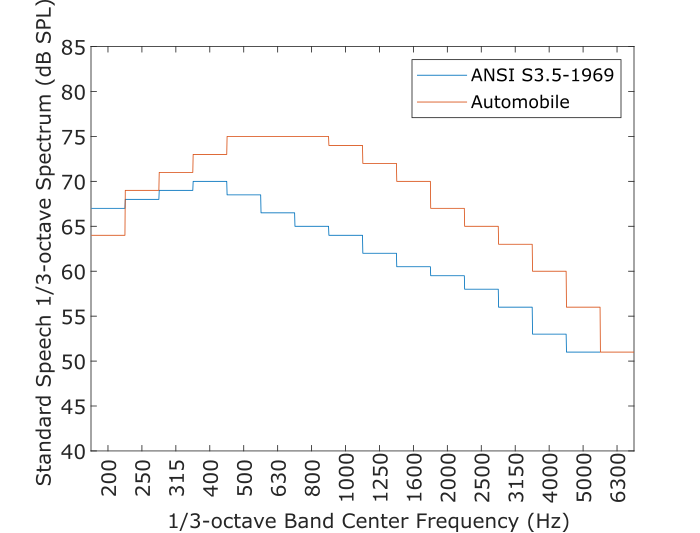Intelligibility
The Intelligibility computation profile allows you to study the intelligibility of human speech in a given noise environment.
Indicators
The Intelligibility profile computes the following indicators:
- Articulation Index ANSI S3.5-1969
- Articulation Index vs Time ANSI S3.5-1969
- Automobile Articulation Index (%)
- Automobile Articulation Index vs Time (%)
The Articulation Index ANSI S3.5-1969 indicator ranges from 0 (speech not intelligible) to 1 (speech perfectly clear).
The Automobile Articulation Index indicator ranges from 0 (speech not intelligible) to 100% (speech perfectly clear).
Articulation Index Standard
In 1969, the American National Standards Institute introduced the ANSI S3.5-1969 standard to evaluate the interference between background noise and human speech.
The Articulation Index (AI) is a sound metric designed to rate the speech intelligibility. It is typically used to study broadband background noises, more specifically the extent to which they alter speech intelligibility.
It relies on the general principle of Masking: if a noise is loud enough, it may mask other sound signals, such as speech.
The frequencies produced in human speech typically go from 200 Hz to about 6000 Hz, and relation to intelligibility is not uniform over this range: some frequency bands are more important than others.
The Articulation Index accounts for this by considering the noise spectrum into separate frequency bands, and by using a different weighting for each of them. For the calculation, one-third-octave bands are used, which are considered as a good approximation of how the human hear divides the frequency spectrum into separate bands (see Critical Bands). The level in each band is then compared to standard one-third-octave speech levels, and the Articulation Index is finally obtained as a weighted sum of the Speech-to-Noise level differences.
The calculation of the Articulation Index therefore includes the following 5 consecutive steps:
- Measurement of the background sound
- Calculation of the noise level within each one-third-octave band
Calculation of the Speech-to-Noise difference in dB in each band
Differences greater than 30 dB and differences smaller than 0 dB are clipped to 30 dB and 0 dB, respectively.
- Multiplication of the difference obtained in each band with the corresponding weighting
- Summation of the weighted differences over all considered one-third-octave bands
Differences between the Articulation Index ANSI S3.5-1969 and the Articulation Index Automobile
The two calculation methods differ in the following points:
- The range of one-third-octave bands considered:
- Between 200 Hz and 5000 Hz for the Articulation Index ANSI S3.5-1969
- Between 200 Hz and 6300 Hz for the Automobile Articulation Index
- The standard one-third-octave-band speech spectrum (see Standard Speech Spectrum)
- The one-third-octave band weightings used (see One-third-octave band weightings)
- The range of output values:
- Between 0 and 1 for the Articulation Index ANSI S3.5-1969
- Between 0 and 100% for the Automobile Articulation Index
Standard Speech Spectrum

One-third-octave Band Weightings
|
1/3 Octave Center frequency (Hz) |
ANSI S3.5-1969 Weightings |
Automobile Weightings |
|---|---|---|
|
200 |
0.0004 |
1 |
|
250 |
0.001 |
2 |
|
315 |
0.001 |
3.25 |
|
400 |
0.0014 |
4.25 |
|
500 |
0.0014 |
4.5 |
|
630 |
0.002 |
5.25 |
|
800 |
0.002 |
6.5 |
|
1000 |
0.0024 |
7.25 |
|
1250 |
0.003 |
8.5 |
|
1600 |
0.0037 |
11.5 |
|
2000 |
0.0037 |
11 |
|
2500 |
0.0034 |
9.5 |
|
3150 |
0.0034 |
9 |
|
4000 |
0.0024 |
7.75 |
|
5000 |
0.002 |
6.25 |
|
6300 |
N/A |
2.5 |


